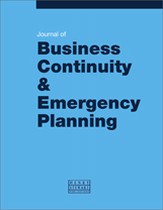Healthcare system resiliency: The case for taking disaster plans further — Part 1
Abstract
To establish true healthcare resiliency, and to better position
healthcare organisations to provide effective response, continuity,
resumption and recovery of fundamental services and operations
during serious incidents and disasters, the disaster planning
process must evolve into an integrated approach of four contingency
planning disciplines that holistically examine the end-to-end,
all-hazard response continuum. This process also needs to
incorporate and scale multifarious organisational levels and, when
required, the health sector. This paper is the first component of
two independent, but related, pieces. It will examine the typical
state of disaster preparedness and plans in healthcare, examine the
worth and value of honing disaster plans, and will introduce two
recommended contingency planning disciplines: enterprise risk
management and emergency response planning. For each discipline, a
case will be made for its inclusion into the overall disaster
planning process, including examination of background information,
benefits, how it improves disaster planning, and other resources
helpful to the reader. The second paper, in a future issue of the
Journal of Business Continuity & Emergency Planning, will introduce
business continuity management — including IT disaster recovery —
and crisis communications as the third and fourth contingency
planning disciplines needed for a fully integrated approach.
The opinions expressed in this paper are those of the
authors and may not be entirely those of the organisation.
The full article is available to subscribers to the journal.
Author's Biography
Michael L. Timmins is an IT disaster recovery specialist at Enbridge Pipelines Inc. He has several years of experience in BCM, emergency management, IT disaster recovery and project management in private, government and healthcare environments. He holds a postgraduate certificate in emergency management and business continuity planning from Sir Sanford Fleming College as well as a bachelor of business administration honours from Trent University. Michael has also successfully challenged the Professional Evaluation and Certification Board’s ‘ISO 22301 Lead Implementer’ exam. He also holds BCM certification from the Disaster Recovery Institute Canada.
Eric A. Bone is Regional Director of the Office of Emergency Preparedness for Capital Health Edmonton and Area. He came to Capital Health in 2003, having completed 28 years in the Emergency Medical System (EMS) field with British Columbia Ambulance. Eric holds a Diploma in Public Administration from the University of Victoria and a Master of Arts in Leadership and Training from Royal Roads University in Victoria. His certification in emergency preparedness comes from the Justice Institute of British Columbia. He is a member of the International Association of Emergency Managers. Eric has authored and contributed to publications including Canadian Journal of Public Health and Disaster, Mass Casualty, Epidemics/Pandemics, and Terrorism Nursing: Textbook of Medical — Surgical Nursing, and has presented to several national and international conferences.
Michael Hiller is the Corporate Business Continuity Manager for Alberta Heath Services. He leads the development and implementation of a province-wide business continuity management (BCM) programme, including education and resource planning. Michael has completed and achieved certification in BCM, disaster recovery, exercising business continuity plans, ICS, business management, and is a standing member of the Education Commission Committee for Disaster Recovery Institute of Canada.
Citation
Timmins, Michael L., Bone, Eric A. and Hiller, Michael (2015, February 1). Healthcare system resiliency: The case for taking disaster plans further — Part 1. In the Journal of Business Continuity & Emergency Planning, Volume 8, Issue 3. https://doi.org/10.69554/ROKS9912.Publications LLP
